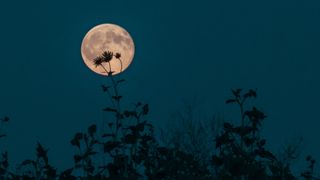Tonight's 'Flower Moon' will rise close to a red supergiant star
May 2024's full moon, also known as the Flower Moon and the Planting Moon, will be at its fullest on Thursday, May 23. It will also appear bright and full on Friday.

May's full moon, known as the Flower Moon, will be at its fullest tonight (Thursday, May 23), and shine close to the bright star Antares. The moon will also appear bright and full on Friday.
May's full moon is called the Flower Moon, after the plentiful flowers that bloom during this month in the Northern Hemisphere, according to Timeanddate.com. Other names for May's full moon include the Milk Moon, Mothers' Moon, Bright Moon, Hare Moon and Grass Moon. Many Anishinaabe, or Ojibwe, Indigenous people of the Great Lakes region know it as Nimebine Giizis, or Sucker Moon, according to the Center for Native American Studies.
Since the moon turns full at 9:53 a.m. EDT on May 23, there is no ideal time this month to watch the full moon rise in a twilight sky.
Related: What would happen if the moon disappeared tomorrow?
Check the moonrise and moonset times for your location and find a place to observe from with a low view of the eastern horizon.
However, tonight you will be able to view it alongside the bright star Antares — the brightest star in the constellation Scorpius, the scorpion. Antares, a red supergiant star, will be visible to the lower left of the full moon as it rises. It has an unmistakable red tint, particularly through a pair of stargazing binoculars or a good small telescope. It's one of the few very bright stars the moon appears close to during its orbit.
The next full moon will be the Strawberry Moon on Friday, June 21. This is the first full moon of summer in the Northern Hemisphere and winter in the Southern Hemisphere, and will occur just a day after the 2024 summer solstice.
Sign up for the Live Science daily newsletter now
Get the world’s most fascinating discoveries delivered straight to your inbox.
Jamie Carter is a freelance journalist and regular Live Science contributor based in Cardiff, U.K. He is the author of A Stargazing Program For Beginners and lectures on astronomy and the natural world. Jamie regularly writes for Space.com, TechRadar.com, Forbes Science, BBC Wildlife magazine and Scientific American, and many others. He edits WhenIsTheNextEclipse.com.